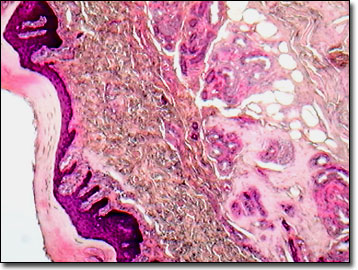Brightfield Digital Image Gallery
Palm and Sole Skin
If the gypsy fortune-teller cannot predict the future from reading one's palms, she certainly can determine that the hands belong to a member of the primate group of mammals. Primates, whether human or nonhuman, feature volar (palm and sole) skin on the hands and feet that is hairless, thickened, heavily keratinized, and dominated by sweat glands.

Referred to also as "thick skin," the palms and soles of a human may be 0.8 to 1.4 millimeters thick to protect against regular pressure and rubbing, while the epithelium on other parts of the body is usually only 0.1 millimeter thick. There are five morphologically distinct layers of the soles and palms, with the stratum basale being the deepest, followed sequentially by the stratum spinosum, stratum granulosum, stratum lucidium, and the outer-most protective layer, the stratum corneum. The stratum corneum is composed primarily of dead cells, which are filled with keratin and that have lost their nuclei. Sloughing of the surface cells from this layer is almost continuous, with subsequent replacement by cells that arise originally via mitosis from the basal layer. Cells in the hands and feet of primates are constantly moving upward toward the free surface until they are also exfoliated.
A characteristic surface pattern exists on the palms of the hands and the soles of the feet, which can be used legally for positive identification of an individual in a manner similar to fingerprinting. Sweat glands, coiled tubular glands of the skin, vary widely in distribution and type in the primate body, with about 3,000 merocrine sweat glands per square inch of volar skin tissue. These sweat glands are classified as eccrine glands, and release salt and urea to the environment, as well as potassium, water, ammonia, serine, heavy metals, and proteolytic enzymes. As many the nervous person and the polygraphist know, emotional stress tends to induce sweating, confined mainly to the soles of the feet and the palms of the hands. It is believed that palmar sweating is linked to a specialization for grasping objects with increased tactile sensitivity while protecting the skin from damage, perhaps as part of the suite of "flight or fight" behaviors.
In some forms of reconstructive or plastic surgery, palm skin has successfully been replaced with sole skin, removed to form a full-thickness graft that covered almost the entire palm of the hand without impairing the weight-bearing areas of the feet or encumbering the gait. In cases such as these, the skin of the palm and sole are preferred for grafts since they are so similar, histologically and in thickness. Health investigators can determine if a person has consumed arsenic by examining for induced keratosis, or an abnormal thickening and roughening of the skin of the palms and soles.
Contributing Authors
Cynthia D. Kelly, Thomas J. Fellers and Michael W. Davidson - National High Magnetic Field Laboratory, 1800 East Paul Dirac Dr., The Florida State University, Tallahassee, Florida, 32310.
BACK TO THE BRIGHTFIELD IMAGE GALLERY
BACK TO THE DIGITAL IMAGE GALLERIES
Questions or comments? Send us an email.
© 1995-2025 by Michael W. Davidson and The Florida State University. All Rights Reserved. No images, graphics, software, scripts, or applets may be reproduced or used in any manner without permission from the copyright holders. Use of this website means you agree to all of the Legal Terms and Conditions set forth by the owners.
This website is maintained by our
Graphics & Web Programming Team
in collaboration with Optical Microscopy at the
National High Magnetic Field Laboratory.
Last Modification Friday, Nov 13, 2015 at 01:19 PM
Access Count Since September 17, 2002: 33387
Visit the website of our partner in introductory microscopy education:
|
|
